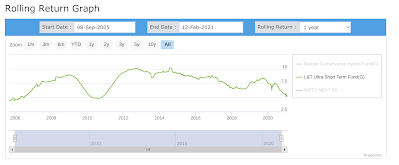Of late, I am fascinated by mutual fund schemes that have some equity exposure, but still maintain a conservative stance prioritising low volatility over high returns. In my previous post, I compared Quantum Multi-Asset fund with ICICI Regular Savings fund. Assessing just on volatility, there’s a better fund than the ICICI fund: it’s Baroda Conservative Hybrid Fund. The fund looked so attractive to me, I started wondering if I should use this fund for the debt part of my portfolio! Allowing equity into the debt portfolio is an unnecessary risk, but the 9% return is alluring (vs the 4% that we get from more stable debt funds).
Thankfully, I am not as impulsive and dumb as I used to be, so I started thinking of ways to accommodate this fund into my portfolio. To decide what value it can add to the portfolio, I decided to look at 1 year rolling returns of the fund. To qualify as a good debt fund, the variability should be within a reasonable range. (All rolling return graphs in this post are screenshots from RupeeVest.com.)
The blue line on the graph is the Baroda fund and the black line is Nifty Next 50 index. Compared to the index, the fund is essentially a flat line, making us think that it’s been very stable. While this graph looked great, I wanted to compare it with my primary debt instrument, the L&T Ultra Short Term Debt Fund. When plotted against the pure debt fund, the variability in the return of the hybrid fund stands out more clearly. The green line (debt fund) is fairly smooth while the blue line (hybrid fund) goes up and down.
To get a better idea of the variability in these 2 funds, I also looked at them in isolation. While both funds have gone up and down in the yield curve, pay attention to the Y axis: the lowest 1 year return from the debt fund is around 4% while the lowest return from the hybrid fund is negative! The debt fund’s returns are in a range of 4 to 10% while the hybrid fund has a wider range of about -1 to almost 20%. The hybrid fund is also hovering below 5% yield far more frequently than the debt fund. Even with equity exposure, one might end up worse off than the pure debt investment.
 |
| 1 year rolling returns of Baroda Conservative Hybrid Fund |
 |
| 1 year rolling returns of L&T Ultra Short Term Debt Fund |
Conservative Hybrid is a category that has lower volatility than other categories like pure equity, balanced advantage, etc. The Baroda fund has one of the lowest volatility numbers even within the Conservative Hybrid category. If this fund cannot add stability and predictability to a portfolio, I think no other fund in the category will. Nor any other fund category with a higher allocation to equity.
Takeaways for me from this exercise:
- Equity exposure, even when the allocation is less than 20%, adds variability to the amount of return you will get.
- If you are just parking some money for a few years, an instrument with some equity exposure is probably okay. But don’t add these funds to the debt portion of your portfolio (why).
- Current interest rates are not at all attractive, and the debt portion of my portfolio is not growing as quickly as I had expected. Simply accepting the low return is a more prudent option than investing in equities to make up for the lost interest. (In other words, don’t risk the capital in your search for more interest.)




No comments:
Post a Comment